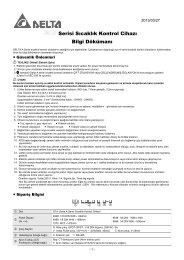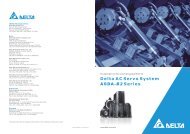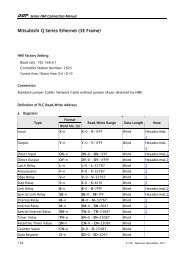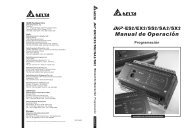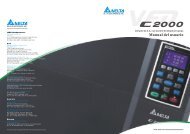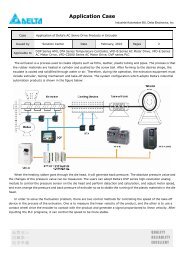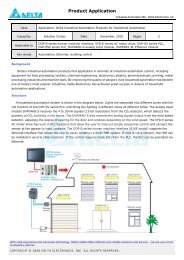1999 Annual Report - Delta Electronics
1999 Annual Report - Delta Electronics
1999 Annual Report - Delta Electronics
You also want an ePaper? Increase the reach of your titles
YUMPU automatically turns print PDFs into web optimized ePapers that Google loves.
Inventories<br />
Inventories are stated at the lower of cost or market value; cost is determined by the standard cost. Variances from<br />
standard cost are allocated to ending inventories and cost of goods sold at the end of each period. When comparing<br />
with market value, current replacement price is used for materials. Net realizable value is used as market value for<br />
work in process and finished goods. Provision is made for obsolete inventories at period-end.<br />
Funds and long-term investments<br />
1) Long-term investments<br />
A. Long-term investments in which the Company owns less than 20% of the voting rights of the investee<br />
company and has no significant influence on the investee company's operational decisions are accounted for by<br />
the lower of cost or market value method, if the investee company is listed, and by the cost method if the<br />
investee company is not listed. Valuation allowance for unrealized loss under the lower of cost or market value<br />
method is shown under stockholders' equity. When it becomes evidently clear that there has been a permanent<br />
impairment in value and the chance of recovery is minimal, loss is recognized in the current year's net income.<br />
If the Company owns at least 20% of the voting rights of the investee company, the investment is accounted for<br />
by the equity method, unless there is evidence that the Company cannot exercise significant influence over the<br />
investee company. The unrealized gains or losses arising from transactions between the Company and investee<br />
companies are eliminated in preparing the financial statements. The Company delays recognition of<br />
investment income (loss) on long-term equity investments in which the Company's voting rights on the<br />
investee company do not exceed 50%, if the investee company's financial statements for the same period are<br />
not available in time, except when certain criteria are met, in which case no delay is possible.<br />
B. Foreign investments in which the Company owns less than 20% of the voting rights of the investee company<br />
are accounted for by the cost method. The original cost is accounted for based on actual remittance amount.<br />
Investments in foreign currency are translated into New Taiwan dollars at the rates of exchange prevailing at<br />
the balance sheet date; unrealized exchange loss (and subsequent recoveries to the extent they do not exceed<br />
original cost) is treated as translation adjustment of long-term investments under stockholders' equity.<br />
The Company's proportionate share of the foreign investee's cumulative translation adjustments related to the<br />
translation of the foreign investee's financial statements into New Taiwan Dollars is recognized by the<br />
Company and is included in a cumulative translation adjustment account in the stockholders' equity.<br />
C. When the Company's proportional interest in an equity investee changes after the equity investee sell additional<br />
shares by the variance between the investment cost and the Company's proportionate share of the net asset of<br />
the investee companies is adjusted first to capital reserve. IF the capital reserve arising from long-term<br />
investment is not sufficient, then retained earnings is debited.<br />
D. If the investee company has gains on disposal of property, plant and equipment, net of applicable income tax,<br />
transferred to capital reserve, such amount will be transferred into capital reserve from retained earnings based<br />
on the ownership percentage in the current year. If the investee company covered prior years' losses using<br />
above capital reserve, capital reserve will be transferred back into retained earnings based on the ownership<br />
percentage.<br />
In addition, any other changes to the investee company's capital reserve will be adjusted by the Company to its<br />
long-term investment account and capital reserve based on its ownership percentage.<br />
E. Under the equity method, the excess of investment cost over the net asset of the investee companies at the date<br />
of investment is amortized over 5 years.<br />
26



